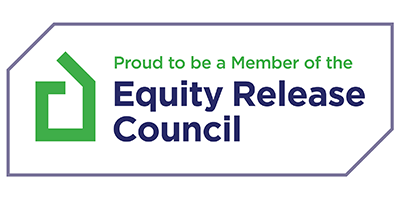In this article
When considering equity release, one of the key factors to think about is the interest rate.
Whether you’re looking to unlock some of the value tied up in your home or need a financial boost during retirement, understanding how interest rates on equity release plans work is essential to making an informed decision.
Interest Rates on Equity Release
Explained in 3 mins 48 seconds
Find more videos like this on MoneymanTV
What is Equity Release?
Before diving into interest rates, let’s briefly touch on what equity release involves. Equity release is a way for homeowners, typically over the age of 55, to access some of the money (equity) in their property without having to sell it.
The two main types are lifetime mortgages and home reversion plans, with lifetime mortgages being the most popular option.
Equity release can also be used to buy a new property also, via a lifetime mortgage, which allows our more mature customers to either get on the property ladder for the first time or to move to a more expensive property.
How Do Interest Rates Work on Equity Release?
Interest rates on equity release plans are slightly different from those on traditional mortgages. With a lifetime mortgage, the most common form of equity release, you borrow against the value of your home, and interest is charged on the amount borrowed.
The key difference is that you don’t usually make monthly repayments. Instead, the interest rolls up, meaning it accumulates over time and is added to the total loan amount.
Because of this, even a small difference in interest rates on equity release can have a significant impact over the long term. It’s important to compare different plans and understand how the interest will grow over time and how you can minimise this.
Fixed Vs Variable Rates
Most equity release plans offer fixed interest rates, which means your rate is locked in for the lifetime of the loan. This provides peace of mind, as you’ll know exactly how much the interest will be over the years.
Some plans offer variable rates, but these are less common and can fluctuate based on market conditions, potentially leading to higher costs down the line.
Speak to an Advisor – It’s Free!
Schedule a free callback from one of our experts today.
- All situations considered
- Transparent and honest mortgage advice
- We search 1000s of purchase and remortgage deals
Our customers rate us 4.9/5
The Impact of Interest Rates on Your Equity Release Plan
The interest rate on your equity release plan plays a big role in determining how much your loan will grow over time. For example, a lower interest rate means less interest will accumulate, leaving more of your home’s value intact for your estate.
On the other hand, higher interest rates on equity release can quickly add up, which could significantly reduce the amount of inheritance you leave behind.
If no monthly payments are made, interest on an equity release mortgage will ‘roll up’, this is where you’ll pay interest on your interest on your interest etc.
When comparing equity release plans, it’s important to look beyond just the initial amount you can borrow. Consider the long-term effects of the interest rate on your overall financial picture. Many providers offer an “illustration” that shows how the loan will grow over time, which can be a helpful tool in understanding the full cost.
Why Interest Rates Vary
Interest rates on equity release plans can vary based on several factors. The provider, the type of plan, the value of your home, and even your age can all influence the rate you’re offered.
Generally, younger borrowers might see slightly higher rates since the loan could run for a longer period, giving the interest more time to accumulate.
How to Minimise Interest on Equity Release
While interest on equity release can accumulate over time, there are several strategies you can use to minimise the overall cost:
Drawdown Lifetime Mortgages
Instead of taking a lump sum, a drawdown lifetime mortgage allows you to withdraw smaller amounts as and when you need them.
Interest is only charged on the funds you’ve taken out, not on the entire amount available. This can significantly reduce the amount of interest that builds up over time.
Retirement Interest-Only (RIO) Mortgages
A retirement interest-only mortgage is another option that allows you to pay just the interest on the loan each month, without the capital rolling up.
This prevents the loan from growing over time, keeping the amount you owe at a steady level. When you pass away or move into long-term care, the loan is repaid, typically from the sale of your home.
Making Voluntary Payments
Some equity release plans allow you to make voluntary payments towards the interest or the capital.
By paying off some of the interest as you go, you can prevent it from compounding, which helps to manage the overall loan size.
Making Overpayments
In addition to voluntary payments, some equity release plans allow for overpayments. Overpayments can be larger lump sums that go directly towards reducing the principal amount, which in turn lowers the amount of interest charged.
This can be an effective way to reduce the total cost of the loan over time.
Using Grants or Loans
Depending on your circumstances, there may be government grants or low-interest loans available that can cover some of your financial needs, reducing the amount you need to borrow through equity release.
This can be a particularly good option if you’re eligible for home improvement grants or other financial assistance.
Seeking Advice from an Independent Broker
An independent broker like us can offer access to a wider range of equity release products, including those with more competitive interest rates.
We can help you compare different plans and find the one that best suits your needs, potentially saving you a significant amount in interest over the life of the loan.
Their expertise ensures that you’re not just getting any plan, but the right one for your financial situation.
Choosing Lower Interest Plans
While this might seem obvious, it’s important to shop around and compare the different equity release plans available.
Some providers offer lower interest rates on equity release than others, which can make a big difference over the life of the loan.
Making the Right Choice
Choosing an equity release plan with the right interest rate is a balancing act between getting the funds you need now and protecting your future financial wellbeing. It’s worth taking the time to shop around, compare offers, and consider the long-term impact on your estate.
Speaking with an independent mortgage broker like us who specialises in equity release can help you navigate the options and find a plan that suits your needs. They can explain how different interest rates on equity release will affect your loan over time and help you choose a plan that aligns with your financial goals.
Interest Rates on Equity Release – Top 10 FAQs
1. What are the current interest rates on equity release?
Interest rates on equity release can vary depending on a variety of factors, including the provider, the type of plan, and your personal circumstances.
Equity release interest rates are competitive and change daily, generally, they’re typically slightly higher than with traditional mortgage products due to the increased administration involved.
It’s important to compare offers from different providers via a broker to ensure you’re getting the best rate possible for your situation.
2. How do fixed interest rates compare to variable interest rates on equity release plans?
Fixed interest rates on equity release plans offer the security of knowing exactly what your interest rate will be throughout the life of the loan. This can provide peace of mind, as there are no surprises or fluctuations in your payments.
On the other hand, variable interest rates can change over time, which might allow you to benefit from lower rates in the future, but they also carry the risk of increasing, potentially raising the overall cost of your plan.
3. Can I switch my equity release plan if interest rates drop in the future?
If interest rates on equity release plans decrease significantly after you’ve taken out a plan, you might be able to switch to a new plan with a lower rate. This process is like remortgaging in the traditional mortgage market.
However, you should be aware of any early repayment charges or exit fees that might apply to your current plan, which could offset the benefits of switching.
It’s a good idea to speak with an independent broker like us to explore your options.
4. How does the interest rate affect the amount I can borrow with equity release?
The interest rate on equity release directly impacts the amount you can borrow. Generally, lower interest rates allow you to borrow more because the cost of the loan over time is less.
Conversely, higher interest rates might reduce the amount you can access, as the lender will account for the increased cost of interest when determining how much they’re willing to lend.
It’s important to balance your need for funds with the long-term costs associated with different interest rates.
5. What impact will the interest rate have on the amount my estate owes when I pass away?
If you choose not to pay a monthly payment, interest rates on equity release significantly influence how much your estate will owe when the loan is repaid.
With a fixed interest rate, you can predict the growth of the loan over time, making it easier to estimate the remaining equity in your home. Higher interest rates lead to faster accumulation of interest, potentially reducing the amount left for your beneficiaries.
Understanding this impact is crucial for estate planning and ensuring that your wishes are met.
6. Are there any penalties for early repayment if I want to pay off some or all the interest?
Many equity release plans allow for early repayments, which can help reduce the overall cost by minimising the interest that accumulates.
However, some plans may include early repayment charges, especially if you repay a significant portion of the loan early in the term.
It’s important to check the terms of your plan and consult with your provider or an independent broker to understand any potential penalties before making extra payments.
7. Are there any penalties for early repayment if I want to pay off some or all the interest?
There are several ways to minimise the interest accrued on your equity release plan. One option is to choose a drawdown lifetime mortgage, where you only take out funds as needed, meaning interest is only charged on the amount you’ve actually borrowed.
Another way is to consider a retirement interest-only mortgage, which allows you to pay just the interest monthly, preventing it from rolling up.
Making voluntary payments or overpayments directly towards the interest or principal can also help reduce the overall loan size. Finally, seeking advice from an independent broker can help you find plans with lower interest rates on equity release, potentially saving you a significant amount in interest over time.
8. What factors determine the interest rate offered on my equity release plan?
The interest rates on equity release plans are influenced by several factors, including your age, the value of your home, and the specific type of plan you choose.
Generally, younger borrowers might be offered slightly higher rates because the loan is likely to last longer, increasing the lender’s risk.
Additionally, the loan-to-value ratio and the condition of your property can also affect the rate.
Different providers have varying criteria, so it’s essential to shop around and compare rates from multiple lenders.
9. How often do interest rates on equity release plans change?
Interest rates on equity release plans, especially fixed rates, remain consistent for the duration of the plan.
However, for those considering a variable rate plan, it’s important to note that rates can change in response to market conditions.
These changes typically occur in line with shifts in the broader financial markets, such as changes in the Bank of England base rate. It’s important to stay informed about potential changes and how they might affect your plan.
10. Is it better to choose a plan with a higher loan amount and a higher interest rate or a lower loan amount with a lower interest rate?
Deciding between a higher loan amount with a higher interest rate or a lower loan amount with a lower interest rate depends on your financial needs and long-term goals.
A higher loan amount might provide you with more immediate funds, but the higher interest rate could lead to a larger debt over time, reducing the equity left in your home.
Conversely, a lower loan amount with a lower interest rate might limit your access to funds now but preserve more of your home’s value for the future.
It’s crucial to balance your current financial needs with the long-term implications of interest rates on equity release when making this decision.







